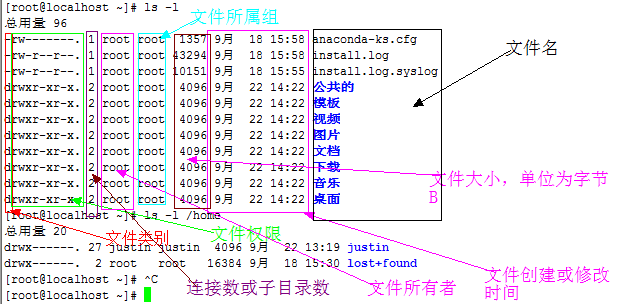您好,登錄后才能下訂單哦!
您好,登錄后才能下訂單哦!
這篇文章主要講解了“CentOS中文件夾的基本操作命令”,文中的講解內容簡單清晰,易于學習與理解,下面請大家跟著小編的思路慢慢深入,一起來研究和學習“CentOS中文件夾的基本操作命令”吧!
文件(夾)查看類命令
ls--顯示指定目錄下內容

說明:ls 顯示結果以不同的顏色來區分文件類別。藍色代表目錄,灰色代表普通文件,綠色代表可執行文件,紅色代表壓縮文件,淺藍色代表鏈接文件。

-a---顯示所有內容,包括隱藏文件
說明:在Linux系統中,以“.”開頭的就是隱藏文件或隱藏目錄。
-l---以長格式(內容更詳細)顯示文件或目錄的詳細信息。

說明:ls -l命令可以簡寫成ll,
輸出的信息共分為7組:
文件類別和文件權限、鏈接數或子目錄個數、文件所有者、文件所屬組、文件大小(單位為字節B)、文件創建或修改時間、文件名。
文件類別:第一組前1位表示文件類別,“-”代表普通文件,“d”代表目錄,“l”代表符號鏈接,“c”代表字符設備,“b”代表塊設備
文件權限:第一組后9位表示文件權限,前3位為user、中間3位為group、后三位為other的權限
-d---顯示目錄本身的屬性而不是目錄中的內容。
1 [root@localhost ~]# ls -ld /home
2 drwxr-xr-x. 4 root root 4096 9月 22 10:41 /home
3 [root@localhost ~]# ls -d /home
4 /home
5 [root@localhost ~]#
-h---以K、M、G等單位顯示文件大小(默認為字節)
1 [root@localhost ~]# ls -h /home
2 justin lost+found
3 [root@localhost ~]# ls -lh /home
4 總用量 20K
5 drwx------. 27 justin justin 4.0K 9月 22 13:19 justin
6 drwx------. 2 root root 16K 9月 18 15:30 lost+found
7 [root@localhost ~]#
-R---若目錄下有檔案,也將檔案依序列出
1 [root@localhost ~]# ls -lR /home
2 /home:
3 總用量 20
4 drwx------. 27 justin justin 4096 9月 22 13:19 justin
5 drwx------. 2 root root 16384 9月 18 15:30 lost+found
6 /home/justin:
7 總用量 32
8 drwxr-xr-x. 2 justin justin 4096 9月 22 10:49 公共的
9 drwxr-xr-x. 2 justin justin 4096 9月 22 10:49 模板
10 drwxr-xr-x. 2 justin justin 4096 9月 22 10:49 視頻
11 drwxr-xr-x. 2 justin justin 4096 9月 22 10:49 圖片
12 drwxr-xr-x. 2 justin justin 4096 9月 22 10:49 文檔
13 drwxr-xr-x. 2 justin justin 4096 9月 22 10:49 下載
14 drwxr-xr-x. 2 justin justin 4096 9月 22 10:49 音樂
15 drwxr-xr-x. 2 justin justin 4096 9月 22 10:49 桌面
16 /home/justin/公共的:
17 總用量 0
18 /home/justin/模板:
19 總用量 0
20 /home/justin/視頻:
21 總用量 0
22 /home/justin/圖片:
23 總用量 0
24 /home/justin/文檔:
25 總用量 0
26 /home/justin/下載:
27 總用量 0
28 /home/justin/音樂:
29 總用量 0
30 /home/justin/桌面:
31 總用量 0
32 /home/lost+found:
33 總用量 0
34 [root@localhost ~]#
-t---將檔案按照建立時間的先后次序列出
1 [root@localhost ~]# ls -l /home
2 總用量 20
3 drwx------. 27 justin justin 4096 9月 22 13:19 justin
4 drwx------. 2 root root 16384 9月 18 15:30 lost+found
5 -rw-r--r--. 1 root root 0 9月 22 15:21 t
6 [root@localhost ~]# ls -lt /home
7 總用量 20
8 -rw-r--r--. 1 root root 0 9月 22 15:21 t
9 drwx------. 27 justin justin 4096 9月 22 13:19 justin
10 drwx------. 2 root root 16384 9月 18 15:30 lost+found
11 [root@localhost ~]#
說明:ls命令還可以結合通配符“?”或“*”一起使用,問號“?”可以匹配文件名中的一個任意字符,而“*”可以匹配文件名中的任意多個字符。這兩個通配符同樣也適用于Shell環境中的其他大多數命令。
1 gssapi_mech.conf popt.d xml
2 gtk-2.0 portreserve yp.conf
3 hal postfix yum
4 host.conf ppp yum.conf
5 hosts prelink.cache yum.repos.d
6 hosts.allow prelink.conf
7 hosts.deny prelink.conf.d
8 [root@localhost etc]# ll -d /etc/po*.d
9 drwxr-xr-x. 2 root root 4096 1月 11 2010 /etc/popt.d
10 [root@localhost etc]# ll -d /etc/po?.d
11 ls: 無法訪問/etc/po?.d: 沒有那個文件或目錄
12 [root@localhost etc]#
du---顯示文件或目錄大小
-h或--human-readable---以K,M,G為單位,提高信息的可讀性
1 [root@localhost src]# du -h nagios-3.5.0.tar.gz
2 1.8M nagios-3.5.0.tar.gz
3 [root@localhost src]# du nagios-3.5.0.tar.gz
4 1748 nagios-3.5.0.tar.gz
5 [root@localhost src]#
-a---顯示全部目錄和其次目錄下的每個檔案所占的磁盤空間
-b或-bytes---顯示目錄或文件大小時,以byte為單位
1 [root@localhost local]# du -b src/nagios-3.5.0.tar.gz
2 1789376 src/nagios-3.5.0.tar.gz
3 [root@localhost local]#
-c或--total---顯示每個目錄或文件的大小外,同時也顯示所有目錄或文件的總和
-m或--megabytes---以1MB為單位
-s---只顯示各檔案大小的總合
1 [root@localhost local]# du -sh src/
2 41M src/
3 [root@localhost local]#
-x---只計算同屬同一個檔案系統的檔案
-L---計算所有的檔案大小
df---顯示檔案系統的狀況;主要用來了解系統中已經掛載的各個文件系統的磁盤使用情況
-h 顯示更易讀的容量單位
-T 顯示文件系統的類型
1 [root@localhost ~]# df -Th
2 文件系統 類型 容量 已用 可用 已用%% 掛載點
3 /dev/sda2ext49.9G 2.6G 6.9G 28% /
4 tmpfs tmpfs 504M 112K 504M 1% /dev/shm
5 /dev/sda1ext4194M 27M 158M 15% /boot
6 /dev/sda5ext47.7G 147M 7.2G 2% /home
7 /dev/sr0iso96602.9G 2.9G 0 100% /media/RHEL_6.3 i386 Disc 1
8 [root@localhost ~]#
file---查看文件類型
1 [root@localhost home]# file justin/
2 justin/: directory
3 [root@localhost home]# file justin1
4 justin1: empty
5 [root@localhost ~]# file install.log
6 install.log: UTF-8 Unicode text
說明:file命令用于查看文件的類型,可以根據文件的內部存儲結構來進行判別,而不根據文件的擴展名來進行判別。在Linux系統中,文件擴展名與文件類型沒有絕對的關系。
文件內容查看
cat---顯示文件內容
1 [root@localhost log]# cat /var/log/messages
說明:cat在顯示文本文件的內容時不進行停頓,對于內容較長的文件,在快速滾屏顯示之后,只有最后一頁的文件內容保留在屏幕中顯示,因此cat不適合查看長文件。
more---分頁顯示文件內容
-num--- 一次顯示的行數
-s ---當遇到有連續兩行以上的空白行,就代換為一行的空白行
+num ---從第 num 行開始顯示
1 [root@localhost log]# more -5s /var/log/messages
2 Sep 22 10:36:06 localhost kernel: imklog 5.8.10, log source= /proc/kmsgstarted.
3 Sep 22 10:36:06 localhost rsyslogd: [origin software="rsyslogd"swVersion="5.8.10"x-pid
4 ="1323"x-info="http://www.rsyslog.com"] start
5 Sep 22 10:36:06 localhost kernel: Initializing cgroup subsys cpuset
6 Sep 22 10:36:06 localhost kernel: Initializing cgroup subsys cpu
7 --More--(0%)
說明:類似 cat ,不過會以一頁一頁的顯示方便使用者逐頁閱讀,空白鍵(space):顯示下一頁,b 鍵:顯示上一頁,q 鍵 :退出
less----分頁顯示文件內容
說明:less命令的用法與more命令類似,它們之間的區別是當文件內容顯示到文件尾時,more命令會自動退出閱讀環境,而less命令不自動退出,用戶仍然可以利用上下鍵來卷動文件,這樣更加有利于對文件內容的反復閱讀。當要結束瀏覽時,要在less命令的提示符“:”后按Q鍵退出
head---查看文件開頭部分的內容
-n 指定顯示的具體行數。
1 [root@localhost ~]# head -5 /etc/passwd
2 root:x:0:0:root:/root:/bin/bash
3 bin:x:1:1:bin:/bin:/sbin/nologin
4 daemon:x:2:2:daemon:/sbin:/sbin/nologin
5 adm:x:3:4:adm:/var/adm:/sbin/nologin
6 lp:x:4:7:lp:/var/spool/lpd:/sbin/nologin
7 [root@localhost ~]#
說明:默認情況下,head顯示前10行內容
tail---查看文件末尾部分的內容
1 [root@localhost ~]# tail -5 /etc/passwd
2 nfsnobody:x:65534:65534:Anonymous NFS User:/var/lib/nfs:/sbin/nologin
3 abrt:x:173:173::/etc/abrt:/sbin/nologin
4 sshd:x:74:74:Privilege-separated SSH:/var/empty/sshd:/sbin/nologin
5 tcpdump:x:72:72::/:/sbin/nologin
6 justin:x:500:500:justin_peng:/home/justin:/bin/bash
7 [root@localhost ~]#
說明:tail命令用法與head命令類似
創建文件(夾)命令
touch---改變檔案的時間記錄,檔案不存在則創建一個空文件
1 [root@localhost home]# touch file1 file2
2 [root@localhost home]# ls
3 file1 file2 justin lost+found t
4 [root@localhost home]#
-a 改變檔案的讀取時間記錄。
-m 改變檔案的修改時間記錄。
-c 假如目的檔案不存在,不會建立新的檔案
說明:在實際使用中經常用于創建新的測試文件。使用文件名作為參數,可以同時創建多個文件。當目標文件已經存在時,將更新該文件的時間標記,否則將創建指定名稱的空文件。
mkdir---Make Directory---創建新的目錄
-p 確保目錄名稱存在,不存在的就建一個。
1 [root@localhost home]# ls
2 justin lost+found t
3 [root@localhost home]# mkdir dir1
4 [root@localhost home]# mkdir dir2/dir
5 mkdir: 無法創建目錄"dir2/dir": 沒有那個文件或目錄
6 [root@localhost home]# mkdir -p dir2/dir
7 [root@localhost home]#
同時創建多級目錄
1 [root@localhost home]# ls
2 justin lost+found t
3 [root@localhost home]# mkdir -p {dir1,dir2/{dir3,dir4}}
4 [root@localhost home]# ls
5 dir1 dir2 justin lost+found t
6 [root@localhost home]# ls dir2
7 dir3 dir4
8 [root@localhost home]#
刪除文件(夾)命令
rmdir---刪除空目錄(若目錄非空刪除中會報錯)
-p 當子目錄被刪除后也成為空目錄的話,則順便一并刪除
1 [root@localhost home]# mkdir -p {dir1,dir2/dir3}
2 [root@localhost home]# ls
3 dir1 dir2 justin lost+found t
4 [root@localhost home]# rmdir dir1
5 [root@localhost home]# rmdir dir2
6 rmdir: 刪除 "dir2"失敗: 目錄非空
7 [root@localhost home]# rmdir -p dir2/dir3/
8 [root@localhost home]# ls
9 justin lost+found t
10 [root@localhost home]#
rm---刪除檔案或目錄
-i 刪除前逐一詢問確認。
-f 即使原檔案屬性設為唯讀,亦直接刪除,無需逐一確認。
-r 將目錄及以下檔案也逐一刪除。
1 [root@localhost home]# mkdir -p dir1/dir2
2 [root@localhost home]# rm -r dir1/
3 rm:是否進入目錄"dir1"? y
4 rm:是否刪除目錄 "dir1/dir2"?y
5 rm:是否刪除目錄 "dir1"?y
6 [root@localhost home]#
感謝各位的閱讀,以上就是“CentOS中文件夾的基本操作命令”的內容了,經過本文的學習后,相信大家對CentOS中文件夾的基本操作命令這一問題有了更深刻的體會,具體使用情況還需要大家實踐驗證。這里是億速云,小編將為大家推送更多相關知識點的文章,歡迎關注!
免責聲明:本站發布的內容(圖片、視頻和文字)以原創、轉載和分享為主,文章觀點不代表本網站立場,如果涉及侵權請聯系站長郵箱:is@yisu.com進行舉報,并提供相關證據,一經查實,將立刻刪除涉嫌侵權內容。